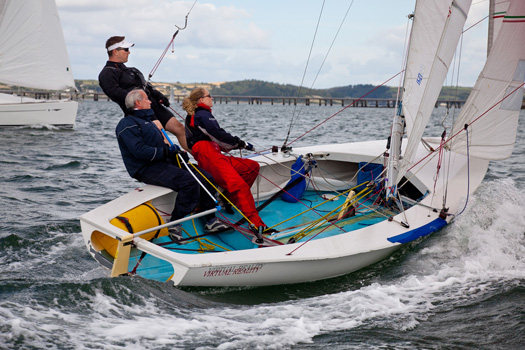Displaying items by tag: Tommy Dwyer
National 18s -72 Years Old and Still Sailing
My first experience of racing was in a National 18 wooden dinghy and it was rough. Inexperienced as a crewman during a race in Monkstown Bay, I slit the top of a finger across a chain plate while pulling in the headsail sheet.
Blood started to pour out of the cut. With the dinghy having only a short freeboard I did what seemed best. To avoid getting blood on the sail which is a heinous crime aboard sailing boats, I put my hand in the water to wash away the blood.
A roar from astern heralded the Skipper's response:
"Get your b....hand out of the water, you're causing drag," which meant I was being accused of the crime of slowing the boat down in a race where there was little wind and every bit of forward momentum was important.
I began to explain and made the mistake of asking where I should put my bloodied finger!
The answer is not printable, but taught me that National 18s didn't take competitive sailing lightly.
I grew to love those boats, their beautiful lines, their speed and their demands on the crew with a spinnaker up. Inevitably, with the cost of maintaining wooden boats, the glass fibre boats (GRP), took over, but the National 18 Class kept going, primarily based in Crosshaven.
Then the 1720s arrived, named after the year when the Royal Cork Yacht Club was founded, powerful new boats which were predicted to wipe out the National 18s. They didn't. Despite becoming very popular for a time, their support declined and the National 18s continued, not alone surviving, but strengthening
This week the Class has announced that it intends to host "the largest gathering of National 18s in the history of this legendary boat."
Next year's Class Championships, better known as the Cock O' the North and sailed in alternative years in Ireland and the UK, where the National 18 is also popular, will be held in Crosshaven from July 24 to 29.
"We are calling on everyone interested to get in touch and take part in what is going to be a great occasion, whether you are a former 18 sailor or someone looking for a new challenge," Class Captain Peter O'Donovan told me. "We are putting in a big effort to get former 18 sailors and their boats back on the water."
It is hoped that at least 50 boats will take part "and perhaps even more," said Peter who has been trawling class records to find former owners and boats which will be arranged in three divisions for the event.
"We decided to include a Classics section, which will encourage those who owned the beautiful wooden, clinker boats, to sail again with us. Some of these boats have reappeared in Crosshaven, we know of others in West Cork and further afield," said Peter.
There will be a section for the "Penultimates," the older fibreglass 18s which "have been hiding in garages, just waiting to be taken out again" and the "Ultimates," the modern fibreglass boats at the front of the present fleet.
"We want to make this a special event and so far there has been interest from Schull, Baltimore, Waterford, Wexford, Arklow and Lough Derg. Further afield, we expect to see visitors from Scotland, the Isle of Man, Essex, Tamesis and Chichester Harbour and we have even had a request for information from Germany."
One of the famous boat building family in Arklow, James Tyrrell, is amongst those who have owned and sailed a National 18. Another sailor of the boats was Peter Crowley, present Chairman of the Irish Sailing Association.
He sailed with Tommy Dwyer from Monkstown who is regarded as an icon of the National 18 fleet in Cobblerod. Tommy now sails Das Boot.

Fun in the National 18. Photo: Bob Bateman
"She was recovered from the bottom of Cork Harbour and I refurbished her. said Tommy, "We named her after the U-boat which featured in the film of that name."Tommy has been sailing National 18s for over 40 years. Every year his name has been amongst the trophy winners.
"For those interested in sailing, we would like to hear from those who would like to crew in the championships," Peter O'Donovan told me. "In addition, we are compiling a list of boats available for charter across the three divisions. For anyone not looking to sail, but just to be part of the event, we will also require assistance with rescue vessels, committee boats and other aspects of the event. It is also hoped to put together a collection of photographs from days gone. We would like to hear from anybody with material. Former 18 sailors who cannot get involved in the event could join us at the Class Dinner and renew acquaintances."
Anyone interested can contact the National 18 class by Emailing Peter O'Donovan at [email protected] or on phone 087 2491720 or Email Kieran O'Connell at [email protected]
The original idea for the building of National 18s was that of Frank Knowling of Whitstable YC in the UK, who later became known as the 'father' of the class. In 1938 he wanted an 18-foot dinghy, suitable for day sailing, yet fast enough to be of interest to racing sailors and at a reasonable cost.
The UK national sailing association and Yachting World magazine organised a design competition won by well-known designer Uffa Fox with a proposal for a clinker-built wooden boat. Another major designer, ¸, had also submitted a proposed boat. The first National 18 was named 'Hurricane,' owned by Stanley Beale and sailed at Whitstable.
It was not until after World War that building of 18s got underway. The Class Association was established in 1947 and by 1950 fleets had appeared at clubs around the coast of Britain and Ireland.
Seventy-two years after the first moves to build National 18s they still survive, a tribute to a great boat.

This article is reprinted by permission of the EVENING ECHO newspaper, Cork, where Tom MacSweeney writes maritime columns twice weekly. Evening Echo website: www.eecho.ie





























































